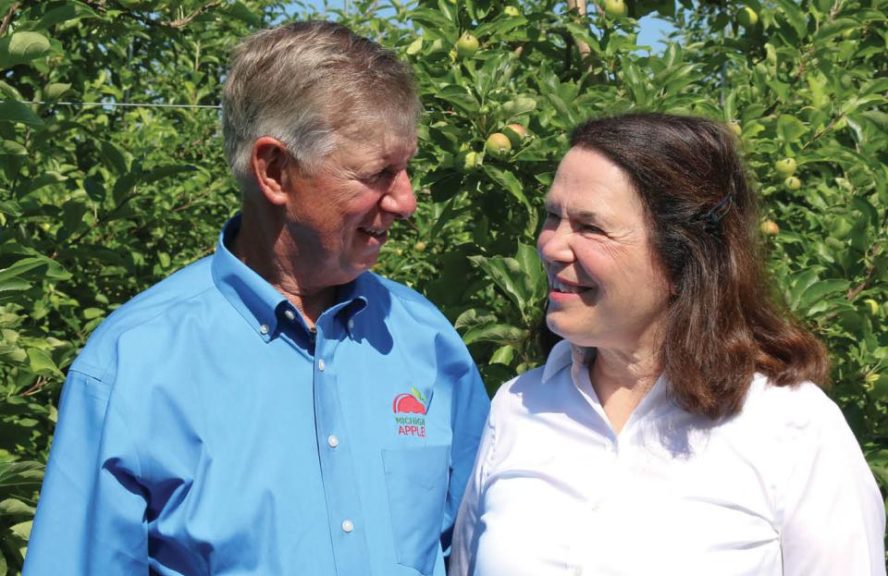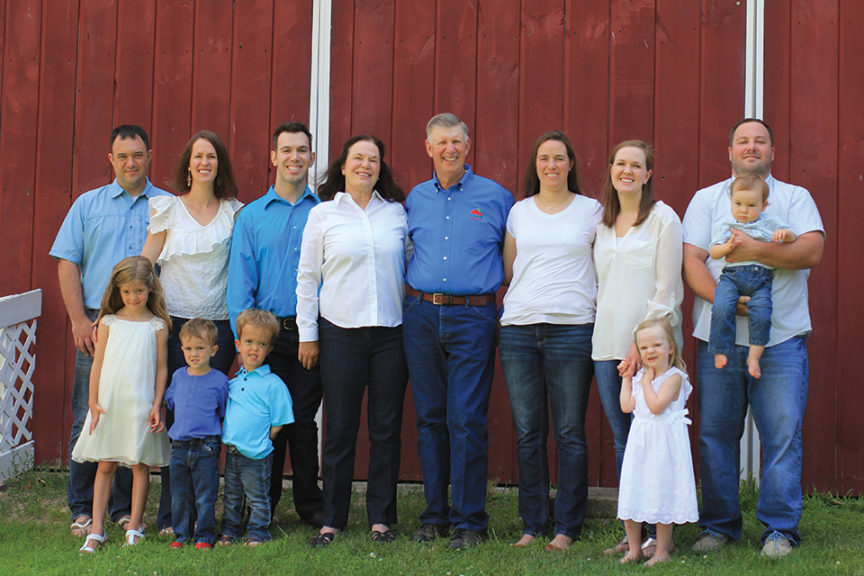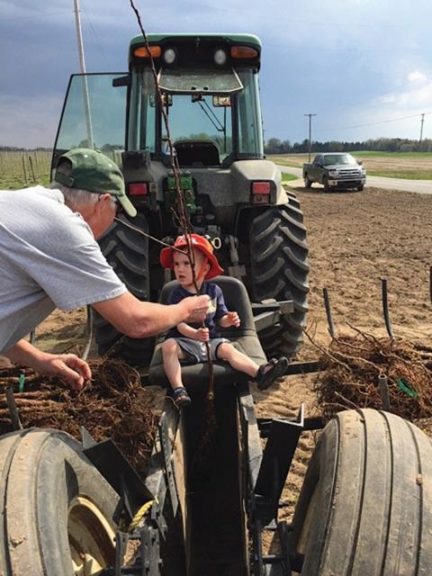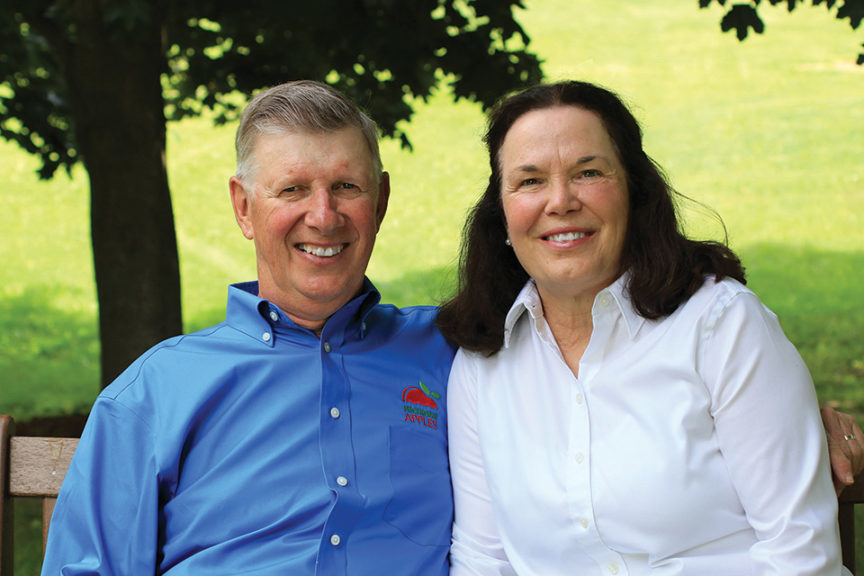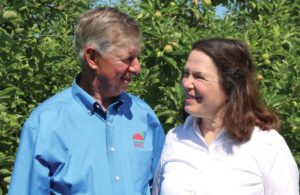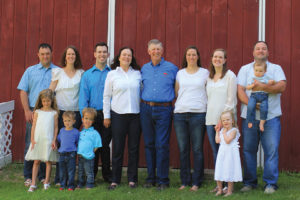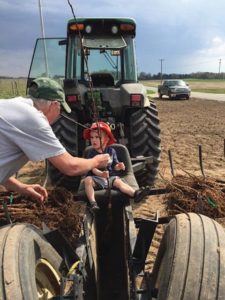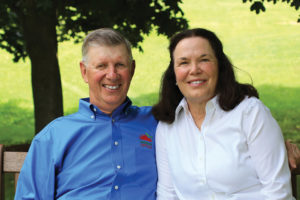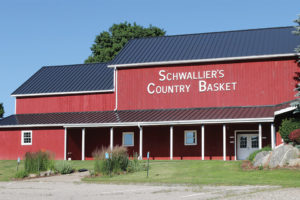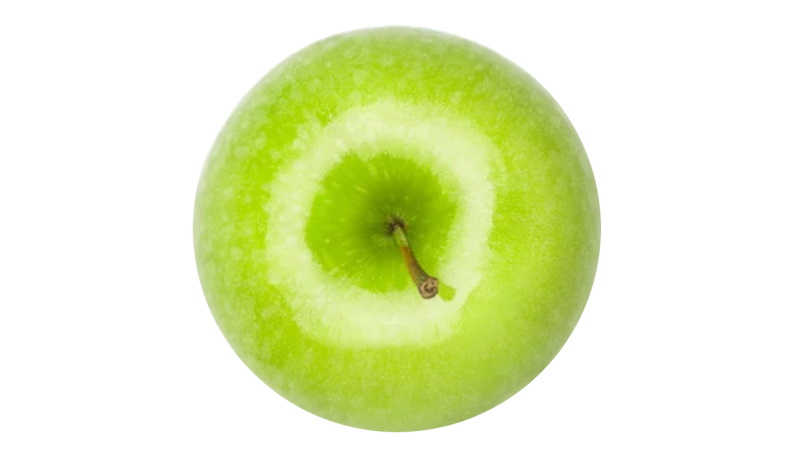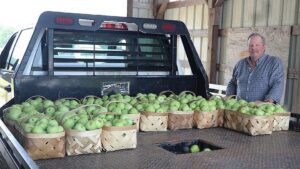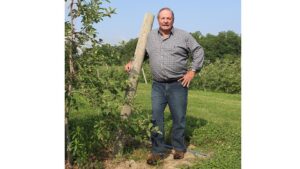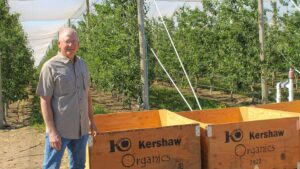Couple’s Approach to Apple Growing is All About Teamwork
In West Michigan lies Peach Ridge, aka The Ridge, an area eight miles wide and 20 miles long so named for its ample fruit production — peaches before the big freeze, apples today. It is blessed with a unique climate formed by its 800-foot elevation and proximity to Lake Michigan, and rich, clay loam soils with excellent water-holding capability. Its residents are as fiercely loyal to it as if it were its own country. And if The Ridge had a king and queen, few would quibble with the coronation of fourth- and fifth-generation apple growers, respectively, Judy and Phil Schwallier.
“Judy and Phil work together as a team to share the bounty of farm life with people of all ages and walks of life,” writes a friend, Cecelia Street, in her nomination for the 2018 American Fruit GrowerSM Apple Grower of the Year Award. “Their mission is to be a part of preserving America’s proud agricultural past as well as to forge its strong future through research and growing practices, educating the public, and opening their land so that people can experience (it).”
In part because of those qualities, American Fruit Grower® and Western Fruit Grower® magazines are pleased to announce Phil and Judy Schwallier of Sparta, MI, are our 2018 Apple Growers of the Year. The Schwalliers will be formally presented with the award, which is sponsored by Valent USA, at the annual U.S. Apple Association Apple Crop Outlook & Marketing Conference in Chicago, Aug. 23-24.
Phil and Judy follow in the footsteps of such early award winners as Grady Auvil and John Rice, as well as recent recipients Scott McDougall and Rod Farrow. The award has gone to husband and wife teams in the past, including Bill and Jeannette Evans in 2014 and fellow Michiganders Harold and JoAnn Thome in 1992.
Harold Thome is still active, and he was on the International Fruit Tree Association’s 2017 Summer Tour when Phil and Judy got the opportunity to show off their beloved Ridge, of course not for the first time. Phil served as IFTA President in 2013-14 and encourages tours of The Ridge, which makes sense as IFTA, then IDFTA, was founded in nearby Hartford in 1958.
Upon introducing IFTA tour-goers on the bus to The Ridge, Phil often tells a joke about why the residents are so devoted. “I’m the third oldest out of nine children, and Judy is fourth of five,” he says. “Judy is related to half the people on The Ridge, and I’m related to the other half.”
Love at First Sight
The Schwalliers met on April 2, 1976, Judy’s 19th birthday. She had gone to see Phil’s band, Petal Fall, and they struck up a conversation during the first break. Back on stage, Phil announced it was her birthday, and just for fun said she was giving out free birthday kisses. But, he told the fellas, be careful.
“I turned around to all the other guys in the band,” he recalls, “and I said, ‘Everybody, stay away from Judy, she’s mine.’”
On his way to picking her up on their first date, Phil was involved in a car accident driving to her house. But he was not hurt, and they were married two years later. They purchased their first farm in 1979, where they still live.
Ten years later, they started their farm market, Schwallier’s Country Basket, which has enjoyed great success in its nearly 30 years. It began as nothing more than a picnic table under a tree by the side of the road. Today, not only do they surpass 200,000 visitors a year, the market is featured on the Grand Rapids Chamber of Commerce list of 100 things to do in the region. On busy days, the line of people waiting expectantly for Judy’s delectable donuts wraps all the way around the bright red barn. But Judy and Phil keep it real.
“When I come home, we talk about the things that need to be done. Usually, Judy says I tell her what needs to be done. But I think it’s she who tells me what needs to be done. And I agree,” Phil says with a smile.
The market is a real family affair, as Phil and Judy have had four children through the years, and all have worked in the market. Today it’s the five grandchildren’s turn.
Even Judy and Phil’s respective fathers worked at the market — when both were in their 90s. Judy’s dad, Carl May, is 93. Phil’s dad, Fred, died in May at the age of 95. From the time Phil was driving a tractor at the age of five, he spent a lot of time by his father’s side, learning how to be a grower and so much more.
“I worked with him for 66 years, I guess you could say, and that’s a real blessing on my part,” he says. “He got me fired up about agriculture and demanded a strong work ethic: Start early, stay late, and work hard.”
Extension’s the Game
Phil got both his bachelor’s and master’s degrees at Michigan State University (MSU). Interestingly, he was the first graduate student under another well-known university researcher, Jay Brunner, who recently retired from Washington State University (WSU). He was also the last one.
“In 1975 Brunner came [to MSU], and I wanted to get my master’s under him. But he left to take [the] WSU job,” Phil says. “He always jokes whenever I see him that I owe him a term paper.”
Meanwhile, Phil was working for MSU Extension District Agent Frank Klackle, supervising IPM advisors for him. He participated in a lot of grower meetings, and that’s when and where he got the idea to pursue a job in Extension. In Grand Rapids, they created a position for Phil, County Horticultural Agent, and he began what is now nearly four decades of working with growers.
“I’ve had the good fortune to work with wonderful growers who have always encouraged me, coached me, and improved the industry. Because of their hard work, progressive attitudes, and backbones, we have many, many young growers coming into the business,” he says. “Our part of the state has the youngest average age for growers; you see many 20- and 30-year-olds at our meetings.”
Amy Irish-Brown, the MSU Extension educator who works closely with Phil, says it makes sense.
“Phil is a great influence on our young, up-and-coming growers,” she says. “They probably have heard from their fathers, their grandfathers: ‘Go ask Phil. What does Phil say?’ So it’s just natural for them to ask as well.”
One of those young growers is Kyle Rasch, who shared what makes Phil so valuable.
“I guess what makes Phil so special to The Ridge — and Michigan in general — is his ability not only to learn but also to apply it to his own farm and turn it into information that growers locally can use,” he says. “Also, I think it’s really key how giving he is with his time. He never turns down a phone call, and he’s on your farm within hours when you need something. It’s really special to have someone like that, someone who’s not only a grower, but also someone who willing to share their knowledge with all the growers in the area.”
Phil, perhaps predictably, says the growers make his job easier.
“I can’t tell you what a good group of people I work with. They are always willing to step up to the plate and help wherever they can,” he says. “They are very progressive — even the young ones. They tell me I do a good job, but I tell them it’s only a mirror reflection of the quality of the people I work with. They are wonderful.”
Perhaps because of that, grower Don Rasch believes Phil is building something that’s going to last a long time.
“He has a special talent for working with up-and-coming younger growers,” he says. “He understands who our future leaders will be, and his wise leadership with them is invaluable.”
Hurray for ‘Honeycrisp’
That talent was tested severely around the turn of the millennium. The U.S. apple industry hit hard times in the late 1990s, but it was even worse in those apple-growing states like New York and Michigan where the thrust of the apple industry was not necessarily fresh consumption.
The apple juice market many of the Northeast and Midwest growers pursued was drying up. China began offering apple juice concentrate at a price that was almost less than what it cost a Michigan grower to harvest his fruit. It became impossible to compete.
For example, in Michigan there were 60,000 acres prior to 2000, says Phil. By 2004, the economic slump had caused the loss of one-third of that acreage. The orchards were razed, or even worse, abandoned.
It wasn’t quite so bad on The Ridge, where growers could adjust better. Pursuing higher prices, they had been planting more apples for the fresh market and fewer processing varieties. That also meant they had younger orchards planted in the new — for the time — high-density configurations.
“The rest of the state had 24-foot, low-density orchards,” Phil says. “You lose money trying to grow apples on those big trees.”
Apple grower R.J. Simons of BelleHarvest recalls those dark days vividly. Phil, who has the almost impossible optimism that infects all fruit growers, seems to have inherited more than his share, he says.
Simons is the current President of the Michigan Pomesters, a nonprofit on The Ridge that aspires to bring together and educate people from all levels in the tree fruit industry. But even such a positive bunch was rocked by the economic hardship.
“For many years, Phil was the Michigan Pomesters,” says Simons. “He kept this group alive on his own as he aimed to continue sharing and informing those around him. He remains a vital resource who we rely on for insight and guidance.”
Of course, Phil had a secret weapon that really was secret in those days: ‘Honeycrisp.’ Because of his position with Extension, Phil says he was one of the first growers to plant ‘Honeycrisp’ — back in 1995. When he began harvesting a few years later, Phil took full advantage, as Judy had given the variety her full endorsement.
“Most people just love that crunch,” she says.
They started giving one free ‘Honeycrisp’ to everyone who came to the farm market. Whether tourists from Chicago or Lansing, or a school group, everybody got a ‘Honeycrisp.’ It was an immediate hit.
“Our business just exploded because of that,” Phil says. “They couldn’t wait to come back to get ripe ‘Honeycrisp.’ People still ask for them by name.”
Today they have about 100 acres of apples, with 98% of the apples sold wholesale and 2% sold on site. They have the old traditional varieties like ‘Cortland’ and ‘Jonagold’ people come to pick every year, along with newer varieties such as ‘Evercrisp’ and ‘SweeTango.’ They continue to try and add new things every year and now have pick-your-own raspberries and a pumpkin patch.
The Schwalliers’ orchards look like any others, except for all the signs and other marks indicating university trials are going on. Those little flags fluttering on the trees in his orchards aren’t just for good looks. He’s always working on any number of research projects. The Michigan Apple Committee alone has funded 39 of Phil’s research projects to the tune of $441,337, says Executive Director Diane Smith.
Though when Smith thinks of the Schwalliers, she thinks about a lot more than research.
“Having dedicated their lives, family, and careers to the industry, Phil and Judy Schwallier represent the epitome of what it means to be apple growers in Michigan.”
Phil’s been testing plant growth regulators for decades and is acknowledged as the expert in the Midwest on thinning apples and achieving maximum crop loads of higher priced, target fruit. About 20 years ago he started doing trials on his own farm, testing products and ideas. About four years ago, he got to wondering how many different trials he had conducted in their orchards, and counted 78.
“I was able to test virtually all the PGRs [plant growth regulators] used in apples because I had my own farm, and I had complete control,” Phil says. “It became a laboratory — something I shared with growers in area. We also used it for all the IFTA tours.”




